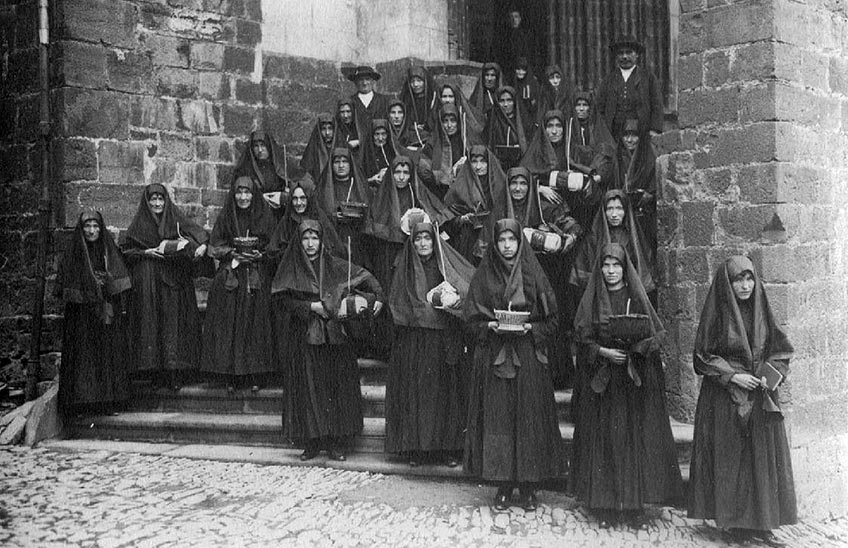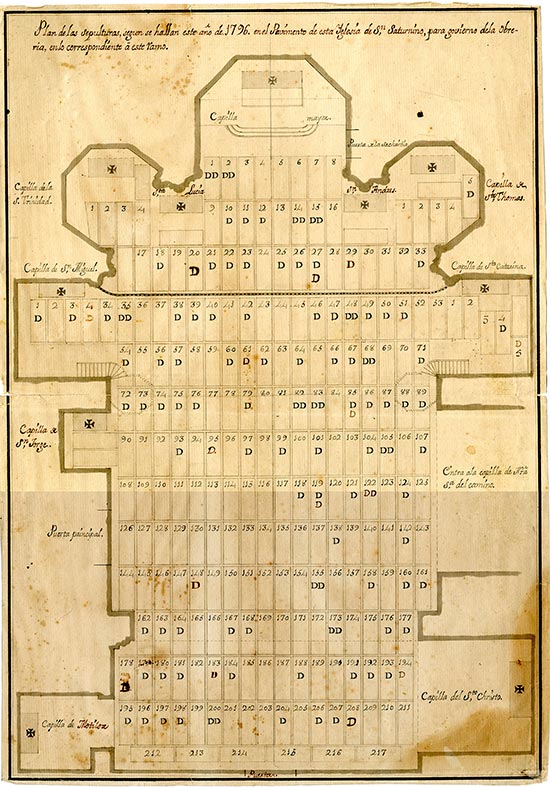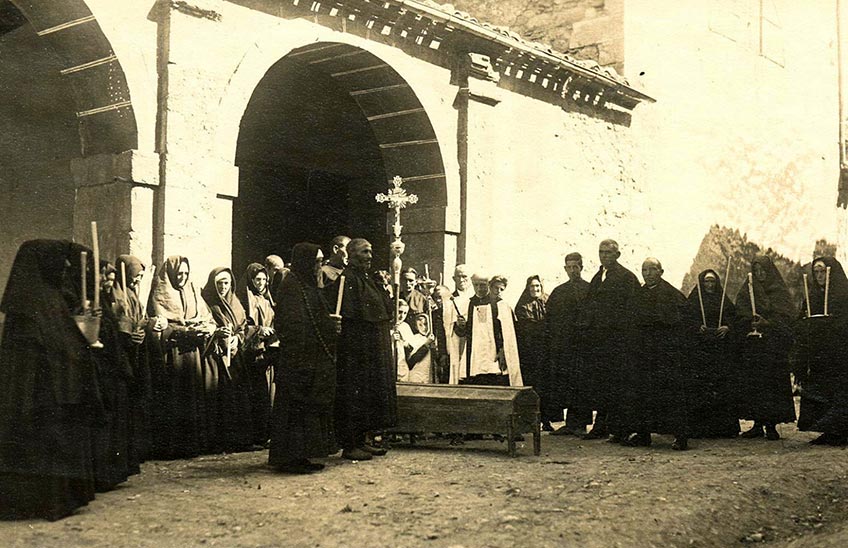Burials, Offerings and Suffrages: Graphic Testimonies of a Lost Religiosity (II)

FotoFotoJosé Roldán, 1924. file General de Navarra/Salacenca women leaving the parish of Ochagavía.
The boxing up of the parish of San Saturnino in Pamplona
The wooden casing or plan for the wooden tombs of San Cernin in Pamplona was drawn up in 1756 by Miguel Antonio Olasagarre and José Antonio Huici, and was approved by Juan Antonio Andrés. Shortly before that, in 1753, the one for the parish of San Nicolás was made by the carpenter Francisco de Aguirre, according to the model that he had just made in the parish of San Lorenzo. That of San Nicolás is still preserved, as is that of the Dominicans in Pamplona. Among the stone casings, the one in the cloister of Los Arcos stands out, executed by the Biscayan stonemason Antonio de Barinaga with design by the Cistercian monk Friar Pascual Galbe in 1752. A But the most important was the cloister of Pamplona Cathedral, with 316 sepulchres, built in 1771 by the master builders José Echeverría and Miguel Armendáriz, following the plan of Juan Miguel Goyeneta.
Focusing on the church of San Saturnino, a plan of the church, preserved in the parish file and dated 1796, contains a list of all the tombs numbered by rows. Don Juan Albizu published, in his monograph of 1930, the owners of all of them, together with some reflections on a fashion that was making headway a century ago, that of flowers and wreaths, which he criticises under the protection of canonical and civil legislation for those who were not children, citing the Novísima Recopilación de Navarra (the New Compilation of Navarre) and other legal texts. He then concludes: "but, unfortunately, in this as in many things, laws are a dead thing and pious and traditional customs are abandoned in order to adopt exotic ones: the liturgical offices and tender prayers of the Church sung by its ministers; the masses; the devout prayers; the wax candles illuminating the sepulchres; the offerings to contribute to the support of the clergy and their ministers, all bear the traditional and Christian stamp; but the flowers in bulk, the wreaths, the five minutes of silence ... that brings the label from America and something smacks of paganism".
The burial could be the exclusive right of a person, or extended or not to their descendants. The latter was in the hands of the Obrería, a kind of parish board with very broad powers. On All Saints' Day, the possessors were obliged to bring a steal of wheat and an axe of wax, which, after being there on the feast of All Souls' Day, remained for the parish. Some people left this burden to their heirs and its fulfilment was obligatory in order to continue with the right to burial. Others preferred to endow the burial with 50 ducats and then it was the Obreria who had to pay for the wheat and the axe, respecting the exclusivity. Those with the letter D on the plan indicate that they were endowed and those with DD indicate that they were doubly endowed.

Plan of the parish church of San Saturnino in Pamplona with the numbered enclosure to identify the graves with a issue corresponding to the families or persons and marking them with a D or two DD (endowed and doubly endowed). 1796
Two snapshots in Ochagavía and Villanueva de Araquil
In 1924, the Pamplona photographic studio of Roldán produced an extensive report for the exhibition on Regional and Historical Costume ( Madrid, 1925), commissioned by the Regional Costume Commission of Navarre. group For the snapshot we present here, a group of women dressed in traditional Salamanca costume posed on the steps of the parish church of Ochagavía, carrying the traditional offering to the dead or the light of the dead with an "argizaiola" on a wicker basket or "eskozaria". According to Iribarren, the former consists of a rectangular board and a handle to roll up the skeins of wax that the women take to the church to light the family grave during funerals, masses and anniversaries.
The photo of Villanueva de Araquil with its neighbours at the door of the church in front of a coffin, on the day of the deceased, was published in the magazine La Avalancha, in November 1931. It was made by Roldán with degree scroll "Responso por los difuntos en el atrio de la iglesia". It is a pity that, unlike other photographs in that publication, the content of the photograph is not explained. No doubt it also serves the same purpose as those taken by the same photographer for the aforementioned exhibition. We can see the preparation of the snapshot with people dressed ad hoc, with traditional clothing and the absolution of the catafalque, in this case a simple coffin, on the day of the deceased, with the ceremonial prescribed by the church for such a celebration.

Response for the deceased in the atrium of the parish church of Villanueva de Araquil. Photo by José Roldán published in La Avalancha on 7 November 1931. Photo library of file Municipal de Pamplona
